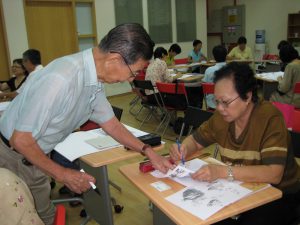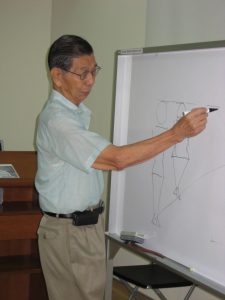Passion in drawing
This senior is not letting age get him down. In his 80s, he is out and about teaching drawing for three hours and loving every moment of it.
BY: Eleanor Yap
 Grandfather of six, Lim Loo Cheong, is a shining example of a senior who at 86 (he turned that age in July) is not about to just hibernate at home. He remains active and healthy, and has a fan base in his grandchildren* as well as some of his students in his basic drawing class on Tuesdays at RSVP – the Organisation of Senior Volunteers, where he instructs on shadows, measurements, movements, scenery and portraits. Soft-spoken and media-shy, it took some convincing for this ex-electrical engineer to sit down for a chat and we are glad he did as he shared many nuggets of information …
Grandfather of six, Lim Loo Cheong, is a shining example of a senior who at 86 (he turned that age in July) is not about to just hibernate at home. He remains active and healthy, and has a fan base in his grandchildren* as well as some of his students in his basic drawing class on Tuesdays at RSVP – the Organisation of Senior Volunteers, where he instructs on shadows, measurements, movements, scenery and portraits. Soft-spoken and media-shy, it took some convincing for this ex-electrical engineer to sit down for a chat and we are glad he did as he shared many nuggets of information …
What were you doing before you retired?
I was a superintendant in charge of running three power stations including at St James (now a club) and at Pasir Panjang. I was also a consultant later on Changi Airport’s electrical infrastructure. The jobs I had were 24-hour type jobs and at Chinese New Year, I would be busy. I retired at 70 and was prepared for it. My wife (who passed away six years ago) said we should have time of our own and to spend it with family and to travel. We got to go to the US, UK and Europe.
 How did you get into drawing?
How did you get into drawing?
I just had an inclination to draw. Art was also one of my subjects in school and I was also drawing every so often. I am mostly self-taught. I joined NAFA three years ago for a course in basic Western art where drawing was the foundation. I learned about oil, watercolour and crayons during this one-year course. I especially like to draw portraits and sceneries. Before that I also attended a number of short drawing classes. For years, I was trying to draw a baby’s face but it always turned into an adult’s face. The teacher at one of those courses told me my figures were in wrong proportion and I was overjoyed to finally figure it out!
How did you get your teaching stint at RSVP?
I went to RSVP really by accident. I saw the publicity about ageing and seniors, and there was an article that said activities like cooking, shopping and drawing keep the mind active and help against dementia. That spurred me to want to teach. I was also then more confident in my drawing. When I attended a talk at RSVP, I brought up my interest in teaching to someone there and you could say the rest is history! I have been there for two years. Sometimes when you see other people’s work, you tend to get ideas on what to do for your own work. I confess I am not an artist; I am very mechanical (thanks to me being an engineer). My students often say I teach science not art but I feel that both link together in some way.
You lost me.
For instance, when one normally draws a face, you would begin by drawing the outline of the face and then put the features in correct proportions. However, I would begin with one eye. This would tell me how big the portrait would be. I would then put lines through it to gauge where the other features fall. My interpretation of art is to present something unusual and pleasing. Once you are familiar with the basics of drawing, you can then deviate out.
Any tips for aspiring artists?
When you are drawing someone on level ground, the further you go away, the smaller the objects in view. It is quite simple and common sense – the nearer, the bigger they become. The eye level ground should also cross all the heads of the people, no matter how big or small they are.
A face must be as big as a palm and you have to be careful not to make a mistake such as making a nose longer than it should, as then you will alter the features.
We often see things with our brain, not our eyes and we should train ourselves to do the opposite. Sometimes also you don’t have to draw everything such as this picture of a lady. I did not outline all her teeth as it won’t look very nice and the way I have done it is a little more subtle.
So have you sold anything?
I don’t feel I am good enough. (This is the same answer Lim used when we asked if he teaches at other places.)
So where do you sketch?
The best place I find is the Esplanade. I sit at one corner where no one will disturb me and I will sketch tourists passing by. I do this once a week. I also borrow books from the library to help me improve in my teaching. Art books are good but they keep referring to somewhere else and then you have to do some more research and you tend to lose track. I only extract the gist from these books. I also sketch at airports during a long-haul journey.
What is your interpretation of drawing?
Drawing is nothing more than putting lines together. It is quite convenient to draw. All you need is a pencil which is easy to carry and cheap, as well as an A5-size sketchbook. You can put them all in a small bag and carry around. When you see something, just take them out. With drawing, you need to have a good memory as you need to remember how each part is connected.
How many sketchbooks would you say you have completed?
I would say about six books.
How has the teaching been going?
I really like the students to ask questions. On those that I don’t know, I will go research and find an answer.
Has drawing rubbed off to any of your family members?
Yes, my 22-year-old grandson who is studying law can draw.
Can you share your secrets to ageing gracefully?
Firstly, keep yourself busy with something you like to do. Sitting around is acceptable as long as you are using your brain. Secondly, have good relations with your family, especially the younger ones, and have something in common with them. In my case, when I find interesting articles in my electrical engineering magazines, I share with them. I get these magazines every monthly and read them to keep myself up-to-date. They are not so high-brow but very user-friendly.
How often do you see your family?
Once a week normally. I follow my son when he picks up the children from tuition and we go for lunch or dinner.
Any tips on being a good grandparent?
Grandparents should always have something in common with their grandchildren as I said before. That way they have something to share or else it would be very difficult to talk to them. Also, grandparents should try to joke with them and be their friends. Your role as a parent is over and this new role is no longer about discipline.
* Two of Lim’s grandchildren gave him a card saying how proud they are of him for staying active.
* If you are interested in joining Lim’s Tuesday drawing class, call RSVP at 6259 0802.

0 Comments